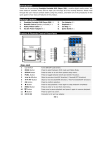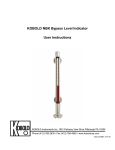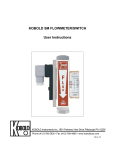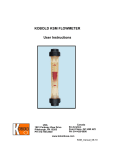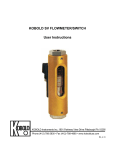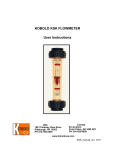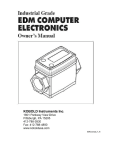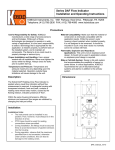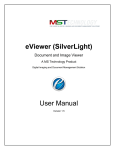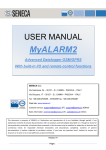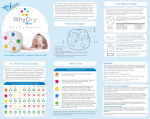Download KOBOLD PSR/PS FLOW SWITCH
Transcript
KOBOLD PSR/PS FLOW SWITCH User Instructions KOBOLD Instruments Inc. 1801 Parkway View Drive Pittsburgh PA 15205 Phone (412) 788-2830 • Fax (412)-788-4890 • www.koboldusa.com Manual-PSR-PS_3-13 PSR/PS Table Of Contents KOBOLD PSR/PS FLOW SWITCH 1.0 General .......................................................................... 1 2.0 Specifications ................................................................ 2 3.0 Installation ..................................................................... 5 3.1 4.0 Contact Protection ......................................................... 5 Operation ....................................................................... 6 4.1 Adjusting Setpoint .......................................................... 6 5.0 Maintenance .................................................................. 7 6.0 Damaged Equipment ..................................................... 7 7.0 Need Help with your PSR/PS ........................................ 7 LIST of DIAGRAMS Diagram 2.4 Diagram of Dimensions ................................................ 4 Diagram 2.5 Diagram of Pressure loss vs. Flow rate ........................ 4 Diagram 4.2 Diagram of Reed Contact ............................................. 6 LIST of TABLES Table 2.1 Table of Technical Data ............................................... 1 Table 2.2 Table of Construction ................................................... 2 Table 2.3a & b Table of Switching Ranges ........................................... 3 Table 3.2 Table Reed Contact - Data ........................................... 5 Rev. 3/13 1 PSR/PS KOBOLD PSR/PS FLOW SWITCH User Instructions CAUTION: 1.0 For safety reasons, please read the cautionary information located at the end of the manual, before attempting installation. General The KOBOLD PSR/PS flow switch is intended for applications in which an electrical switching function is required once a specific flow is achieved. The PSR/PS can be set to operate as either a normally-open (N/O) or normally-closed (N/C) switch. Switching is done with a reed contact which is electrically isolated from the flowing medium. The device operates through use of a paddle-spring arrangement. The flowing medium exerts force on the lower part of the paddle ( in the T-piece ). The paddle pivots about a point higher in the PSR/PS body but is resisted by a leaf spring. On the upper part of the paddle is a magnet, which moves as the paddle pivots about its center. A reed switch is located outside the PSR/PS housing ( thus hermetically isolated ) inside a movable plastic housing. As the magnet nears the reed switch, the switch closes. By moving the reed switch, the flow required to close it is altered. The result is a flow-sensitive reed switch, with adjustable switch point. 2.0 Specifications Table 2.1: Technical Data Operating Principle: Spring resisted paddle Dimensions: See Diagram 2.4 Ranges: See Diagram 2.3a & 2.3b Maximum Pressure: Most Brass/SS units: 1450 PSIG (100 Bar) NOTE: PSR-5132 & PSR-5140: 360 PSIG (25 Bar) Maximum Medium Temperature: 230 Degrees F (110 Degrees C) Maximum Ambient Temperature: 150 Degrees F ( 65 Degrees C) Reed Switch Specifications: See Table 3.2 Rev. 3/13 PSR/PS 2 Table 2.2: Construction Housing (1,4,6) Brass SS Impact Plate (3.1) 304 SS 304 SS Leaf Spring (3.4) 301 SS 301 SS Lever (3.2) 301 SS 301 SS Locking Plate (5) Brass Brass Housing (7) Polyamide GFR* Polyamide GFR* Cabling (8) PVC PVC O-Ring (2) Buna-N FKM Magnet (3.3) Ceramic Ceramic *GFR - Glass Fiber Reinforced Rev. 3/13 3 PSR/PS Table 2.3a: Switching Ranges - PSR Stand Conn. NPT Stand. switching ranges Increasing Decreasing GPM Water GPM Water Flow switch model PSR Brass SS 1/4” 0.9-1.3 0.6-1.2 PSR 5105 PSR 5205 3/8” 1.0-1.6 0.7-1.5 PSR 5110 PSR 5210 1/2” 1.3-2.1 1.0-2.0 PSR 5115 PSR 5215 3/4” 3.0-4.0 2.2-3.0 PSR 5120 PSR 5220 1” 3.2-5.0 2.4-4.5 PSR 5125 PSR 5225 1 1/4” 4.9-8.5 3.8-7.8 PSR 5132 PSR 5232 1 1/2” 9.2-15.0 7.9-14.3 PSR 5140 PSR 5240 Table 2.3b: Switching Ranges - PS Stand. switching ranges Decreasing Increasing GPM Water GPM Water Stand. conn. NPT 2” 18-24 16-22 1/2” 3” 48-66 45-62 1/2” 4” 84-106 79-101 1/2” 6” 185-242 176-237 1/2” 2” 13-16 11-15 1/2” 3” 41-48 38-44 1/2” 4” 57-70 53-66 1/2” 6” 147-159 137-156 1/2” 4” 24-30 19-27 1/2” 6” 53-75 44-62 1/2” 8” 101-141 88-123 1/2” Pipe Size Flow switch Model PS Material Brass SS PS-5149 PS-5249 PS-5152 PS-5252 PS-5114 PS-5214 Rev. 3/13 PSR/PS 4 Diagram 2.4 Dimensions - PSR/PS Order Number Dimensions (inches) PS-5149/PS-5249 PS-5152/PS-5252 PS-5114/PS-5214 PSR-5105/PSR-5205 PSR-5110/PSR-5210 PSR-5115/PSR-5215 PSR-5120/PSR-5220 PSR-5125/PSR-5225 PSR-5132/PSR-5232 PSR-5140/PSR-5240 A 3.66 5.25 7.55 1.97 1.97 1.97 2.05 2.2 2.6 2.6 B 2.32 2.22 4.52 0.39 0.39 0.39 0.59 0.59 - C 1.34 3.03 3.03 3.15 3.15 3.15 3.21 3.31 3.5 3.62 D 0.78 0.75 0.75 - HEX1 0.87 1.06 1.06 1.06 1.06 1.06 1.25 1.54 1.97 2.36 HEX2 1.18 1.18 1.18 1.18 1.18 1.18 1.18 1.18 1.18 Thread (NPT) 1/2" 1/2" 1/2" 1/4" 3/8" 1/2" 3/4" 1" 1 1/4" 1 1/2" Diagram 2.5: Pressure Loss vs. Flow Rate Pressure Drop: The pressure drop of the flow switch is mostly due to the size of the paddle and resulting resistance to flow. The data given in the diagram is valid for units with the standard set point ranges. The pressure drop is less for units with the special set point ranges in the table. The set point ranges are those over which the contact can be adjusted. The high grade stainless spring steel beam enables actual flow rates to be significantly higher without causing damage. There would however be a higher pressure drop. Rev. 3/13 5 3.0 PSR/PS Installation Instructions CAUTION: For Safety reasons, please read the cautionary information located at the end of the manual, before attempting installation. The PSR/PS is installed directly in the pipeline. The PSR/PS is supplied with NPT or BSP threads. Use of PTFE tape is recommended to aid installation. Note that the PSR must be installed so that flow direction in the pipe is as indicated by the arrow on the T-piece. The flow direction arrow on the PS series is stamped on the clamp plate. The reed contact is simply an open/closed type of switch - connect appropriately. Ensure that loads on the switch do not exceed the maximum ratings as given in Table 3.2. Remember that capacitive and inductive loads (such as motors) exhibit much greater voltage/current requirements at start-up and shut-down than the typical operating values. 3.1 Contact Protection Maximum values of current and voltage must not be exceeded on the reed switch. When driving inductive or capacitive loads, we recommend the use of an isolation relay. KOBOLD supplies a line of relays for such instances. Table 3.2: Reed Contact - Electrical Data Maximum Current: 1.5A Maximum Voltage (SPST): 250 VAC Maximum Voltage (SPDT): 150 VAC Maximum Power Dissipation (SPST): 50 VA / 50 W / 1.5 A Maximum Power Dissipation (SPDT): 20 VA / 20 W / 0.5 A Electrical Cable Length: 5 ft. (Std.) Environmental Protection: NEMA 4 / IP 65 Rev. 3/13 PSR/PS 4.0 6 Operation As described in Section 1.0, the PSR/PS uses a paddle to activate a reed contact located at the top of the instrument. The reed contact is simply a N/O or N/C switch, and should be wired as such. 4.1 Adjusting the Setpoint Diagram 4.2: Adjusting the Setpoint The PSR/PS is pre-adjusted at the factory as a normally open (N/O) switch, set to switch in approximately the middle of its range. To change the setpoint, consult Table 2.2: Construction, and do as follows: Slightly loosen the clamp plate screws (5) to allow movement of the reed contact (7). Decide whether you want to retain the normally open (N/O) or change to the normally closed (N/C) switching function. The switch functions as an N/O switch when the switch assembly (7) is positioned such that the tip of the red arrow is just emerging from flow switch housing (4). The switch functions as an N/C switch when the switch assembly (7) is positioned such that the tip of the white arrow is just emerging from flow switch housing (4). The switch becomes less sensitive to flow (i.e activates at a higher flowrate) as more of the arrow point is displayed (pulled out) of the housing. When the red arrow is almost completely pulled out from the flow switch housing, the switch function will transition from N/O to N/C. The N/C switching sensitivity can then be adjusted in similar fashion as noted above. Rev. 3/13 7 PSR/PS Note: If during adjustment, the switch assembly (7) is pulled too far out of the flow switch housing (4), the switch will not function when the impact plate (3.1) is deflected. If this occurs, simply slide the switch assembly back into the housing until the contact functions as desired. If switch is removed, note that the arrow points face opposite to the normal flow direction. 5.0 Maintenance Due to the simple construction of the PSR/PS, it is nearly maintenance free. Should cleaning ever be required, simply release pressure in your system, loosen the lock nut (Diagram 2.2, Item 6) on the PSR/PS and pull the body straight up. Clean as necessary and replace. During replacement, note that the pivot plate of the balance arm (Item 3.2) is keyed to the T-piece (Item 1). The instrument must be reassembled with the keys properly aligned in order to function properly. 6.0 Arrival of Damaged Equipment Your instrument was inspected prior to shipment and found to be defect-free. If damage is visible on the unit, we advise that you carefully inspect the packing in which it was delivered. If damage is visible, notify your local carrier at once, since the carrier is liable for a replacement under these circumstances. If your claim is refused, please contact KOBOLD Instruments for further advisement. 7.0 Need help with your PSR/PS Call one of our friendly engineers at 412-788-2830. Rev. 3/13 9 PSR/PS Caution PLEASE READ THE FOLLOWING GENERAL FLOW METER / MONITOR WARNINGS BEFORE ATTEMPTING INSTALLATION OF YOUR NEW DEVICE. FAILURE TO HEED THE INFORMATION HEREIN MAY RESULT IN EQUIPMENT FAILURE AND POSSIBLE SUBSEQUENT PERSONAL INJURY. Rev. 3/13 PSR/PS 10 • KOBOLD manufactures a wide range of process sensors and technolgies. While each of these technologies are designed to operate in a wide variety of applications, it is the user’s responsibilty to select a technology that is appropiate for the application, to install it properly, to perform tests of the installed system, and to maintain all components. The failure to do so could result in property damage or serious injury. • Inspect instrument for damage upon arrival. Cracked, fractured, bent, or otherwise damaged instruments must not be put into use, since the device is weakened to an unknown extent. (The opeartions and installation guide will explain how to make a claim on damaged instruments.) • Make sure that the model which you have selected is chemically compatible with the application liquids. While the meter is liquid and spray resistant when installed properly, it is not to be immersed. • Under NO circumstances must the maximum tolerances (temperature and pressure) be exceeded. • The maximum tolerances of the device have been determined using water, air and/or oil. If using other media, especially corrosive ones, it is critically important that the user determine chemical compatibility with our instruments. A list, detailing material composition of our instruments, is available from KOBOLD Instruments Inc. upon request. KOBOLD Instruments Inc. cannot accept responsibilty for failure and consequences resulting from use of media other than water, mineral oil, air, and nitrogen. • Install the devices in a fully supported position within your flow system. This avoids excessive stresses which may damage the instrument. In particular: a. Ensure that the plumbing leading to and from the instrument is fully supported and that the instrument does not perform the physical function of a joint. b. When calculating stress on the device caused by plumbing, the weight of the medium in the pipes must be considered as well. c. Misaligned runs of rigid piping can cause large stresses when connected to the instrument. Do not connect in such a fashion. • During installation, avoid stresses on the instrument by following guidelines given below: a. When connecting fittings, hold the instrument fittings rigid with a correctly sized wrench. Do not install by twisting the instrument into the pipe fittings. b. Do NOT install holding the device housing to provide counter-torque to the pipe fitting. Rev. 3/13 11 PSR/PS c. Use an appropiate amount of PTFE tape on male threads of fitting. This reduces the twisting stresses produced by tightening the fittings into each other. d. Do not use pliers or wrenches on the housing, as this may damage it. e. Do not overtighten, as this may fracture the fittings. • During operation, there are a number of situations to avoid: a. The sudden cessation of fluid flow causes what is typically referred to as “water hammer”. Most people are famailar with this phenomenon from their home experience - it is the cause behind the loud clank of water pipes which occurs when faucets are turned off too suddenly. The cause behind this “water hammer” is quite easy to visualize. Water is fairly massive. The amount of water in long runs of pipe is quite substantial. When the faucets are turned off suddenly, especially from a full on condition, the water has considerable momentum and does not want to stop flowing. The situation is similar to stopping a car by running into a wall, rather than by applying brakes. Both are sudden rather than gradual. The damage to the wall can be substantial (not to mention the car). The “water hammer” causes surges in fluid pressure which could cause the measurement instrument’s pressure limit to be exceeded, resulting in failure and possible personal injury. b. Fluid surges, as well as the water hammer, can be particularly damaging to empty flow meters since there is no back pressure in the device. The damage is caused, once again, by momentary excess pressure. To avoid these surges, fluid lines should remain full (if possible) and water flow should be introduced to the device slowly. c. If the instrument is isolated with inlet and outlet valves, the flow meter must be completely drained when said valves are both closed. Failure to do so could result in damage to the device caused bt thermal expansion of fluid. d. Freezing of water in the instrument must be avoided since the resultant expansion will damage the flow meter and make it unsafe for use. • Design a fail-safe system a. Design a fail-safe system that accomodates the possibilty of switch or power failure. In critical applications, KOBOLD recommends the use of redundant backup systems and alarms in addition to the primary system. Rev. 3/13













